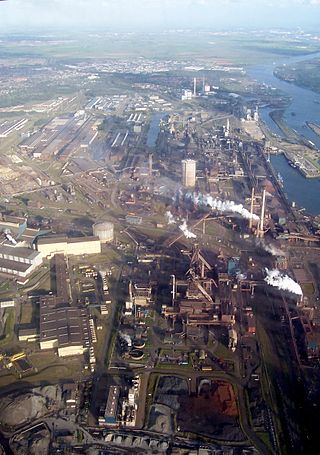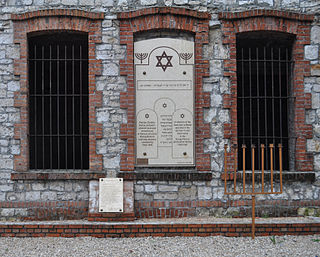
The Krupp family is a prominent 400-year-old German dynasty from Essen, noted for its production of steel, artillery, ammunition and other armaments. The family business, known as Friedrich Krupp AG, was the largest company in Europe at the beginning of the 20th century, and was the premier weapons manufacturer for Germany in both world wars. Starting from the Thirty Years' War until the end of the Second World War, it produced battleships, U-boats, tanks, howitzers, guns, utilities, and hundreds of other commodities.

Blohm+Voss (B+V), also written historically as Blohm & Voss, Blohm und Voß etc., is a German shipbuilding and engineering company. Founded in Hamburg in 1877 to specialise in steel-hulled ships, its most famous product was the World War II battleship Bismarck. In the 1930s, its owners established the Hamburger Flugzeugbau aircraft manufacturer which, shortly before the outbreak of World War II, adopted the name of its parent company. Following a difficult period after the war, B+V was revived, changing ownership among several owners, as Thyssen Group and Star Capital. In 2016, it became a subsidiary of Lürssen and continues to supply both the military and civilian markets. It serves two areas – new construction of warships as NVL B.V. & Co. KG, and new construction and refitting of megayachts. The company has been in operation, building ships and other large machinery, almost continuously for 147 years.

Dortmund is the third-largest city in North Rhine-Westphalia, after Cologne and Düsseldorf, and the ninth-largest city in Germany. With a population of 609,000 inhabitants, it is the largest city of the Ruhr as well as the largest city of Westphalia. It lies on the Emscher and Ruhr rivers in the Rhine-Ruhr Metropolitan Region, the second biggest metropolitan region by GDP in the European Union, and is considered the administrative, commercial, and cultural centre of the eastern Ruhr. Dortmund is the second-largest city in the Low German dialect area, after Hamburg.

Alfried Felix Alwyn Krupp von Bohlen und Halbach, often referred to as Alfried Krupp, was a German industrialist, a competitor in Olympic yacht races, contributor to the SS and a member of the Krupp family, which has been prominent in German industry since the early 19th century. He was convicted after World War II of crimes against humanity for the genocidal manner in which he operated his factories and sentenced to twelve years in prison, subsequently commuted to three years with time served in 1951.

Koninklijke Hoogovens known as Koninklijke Nederlandse Hoogovens en Staalfabrieken (KNHS) until 1996 or informally Hoogovens. was a Dutch steel producer founded in 1918. Since 2010, the plant is named Tata Steel IJmuiden.

Walter Behrendt was a German politician of the Social Democratic Party (SPD) and president of the European parliament (1971–1973).

Deutsche Luft Hansa A.G. was a German airline. It served as flag carrier of the country during the later years of the Weimar Republic and throughout Nazi Germany, when it had close links to the Nazi Party.

Stadion Rote Erde is a 25,000 capacity football and athletics stadium in Dortmund, North Rhine-Westphalia. It serves as the home stadium to Borussia Dortmund II and several athletic clubs. The stadium was built in between 1924 and 1926 at a cost of 1.8 million German Mark. The stadium was inaugurated in 1926, with a match between the City of Dortmund and FC Wacker München (1-11).
Estel was a steel company formed by the merging of Koninklijke Hoogovens IJmuiden steel plant and Hoesch's main steel plant in Dortmund. The company existed from 1972 to 1982 until de-merged.

Thyssen was a major German steel producer founded by August Thyssen. The company merged with Friedrich Krupp AG Hoesch-Krupp to form ThyssenKrupp in 1999.

The Vereinigte Stahlwerke AG was a German industrial conglomerate producing coal, iron, and steel in the interbellum and during World War II.

The Secret Meeting of 20 February 1933 was a secret meeting held by Adolf Hitler and 20 to 25 industrialists at the official residence of the President of the Reichstag Hermann Göring in Berlin. Its purpose was to raise funds for the election campaign of the Nazi Party.

The Alfried Krupp von Bohlen und Halbach Foundation is a major German philanthropic foundation, created by and named in honor of Alfried Krupp von Bohlen und Halbach, former owner and head of the Krupp company and a convicted war criminal.

HASAG was a German metal goods manufacturer founded in 1863. Based in Leipzig, it grew from a small business making lamps and other small metal products by hand into a large factory and publicly traded company that sold its wares in several countries. During the Second World War, Hasag became a Nazi arms-manufacturing conglomerate with dozens of factories across German-occupied Europe using slave labour on a massive scale. Tens of thousands of Jews from Poland, and other prisoners, died producing munition for Hasag.
Erich Maschke was a German historian, history professor, and Nazi ideologue. He last taught at Heidelberg University. During the Nazi era he promoted racist and nationalist ideology. After the war he led the so-called Maschke Committee, commissioned by the West German parliament, which investigated the treatment of German prisoners-of-war during and after World War II by the Allies.

The Westfalenhütte is an industrial site in the northeast of Dortmund, Germany. It was established by the steel company Hoesch AG in 1871. At the peak of the so-called Wirtschaftswunder approximately 25,000 people were working there. Following changes in the steel industry and a consolidation process in the sector, activities on the Westfalenhütte were reduced to a few, economically sustainable core areas. Today more than 1,000 people are working on the site of the Westfalenhütte.

The following is a timeline of the history of the city of Dortmund, Germany.
The Wilhelm Gustloff Stiftung was a state-owned trust set up by the government of Nazi Germany in 1933. Named after Wilhelm Gustloff, a leader of the Nazi Party's Swiss branch who was later assassinated, it was funded by money and property confiscated from German Jews. It was disbanded like all other Nazi organizations in 1945, after the fall of Nazi Germany.

Leopold Hoesch was a German entrepreneur. In 1871 he founded the Eisen-und Stahlwerk Hoesch AG, later the Westfalenhütte in Dortmund, Westphalia.
















